Article Archive
Using Infrared Sightglasses to Protect Against Arc-Flash Exposure
Antony J. Holliday
IEEE Member
Hawk IR International, Ltd.
17 High Street, Marske-by-Sea
Redcar, Cleveland TS116JX
United Kingdom
Ph: 877-442-9547
Abstract
This paper explores the applicable standards currently in place in industry and assesses their impact on infrared sightglass and port design, implementation and corresponding safety in use.
Introduction
The intense energy and duration of an electric arc-flash represents a very unique exposure. Everyday work clothes made from regular cotton or polyester-cotton blended fabrics, regardless of weight, can be readily ignited at some exposure level. Once ignited, the clothing will continue to burn, adding to the extent of the injury sustained from the arc alone. The National Fire Protection Association (NFPA), “Standard for Electrical Safety Requirements for Employee Workplaces”, now requires employees to wear flame resistant (FR) protective clothing wherever there is possible exposure to an electric arc-flash. This clothing must meet the requirements of ASTM International, formally known as the American Society for Testing and Materials (ASTM), document reference F1506. It also requires employers to perform a flash hazard analysis to determine the flash protection boundary distance.
Discussion
NFPA 70E is the standard for the protection of employees working inside various flash protection boundaries. It specifies a level of protective clothing for the corresponding Hazard/Risk Category. The rating of the clothing must have an ATPV of at least the value listed in the “Protective Clothing Characteristics” section of the standard. The Occupational Safety and Health Administration (OSHA) has confirmed that garments which meet the requirements of ASTM F1506 are in compliance with OSHA 29 CFR 1910.269: Electrical Power Generation, Transmission and Distribution.
Infrared Viewing Systems for Electrical Equipment
Infrared scanning must be performed with the target equipment energized. Infrared cameras cannot “see” through panel covers. Consequently, thermographers face severe safety hazards when attempting to scan electrical distribution equipment. The installation of infrared sightglasses (windows or ports) is an excellent solution to this predicament. However, special care must be taken to ensure that the construction of the sightglass does not put the thermographer or the equipment at risk. As IR sightglasses are a new and emerging technology, there are no specific standards that relate to approved sightglass construction and testing. This has lead to potentially dangerous materials being incorporated into some IR sightglass assemblies.
As user requirements for IR sightglasses vary from some of the more traditional switchgear type applications, testing and certification needs to be generic. This ensures that the product will be suitable for general purpose applications.
“Viewing Pane” Standards, IEEE C37.20.2 A3.6
15kV Metalclad Switchgear to IEEE C37.20.21
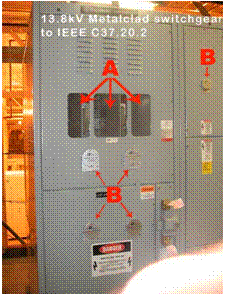
Figure 1 illustrates a medium voltage disconnect manufactured by a major OEM in accordance with IEEE C37.20.2. This example clearly shows both viewing panes for any time visual inspection and also IR sightglasses for periodic infrared inspection, highlighted A & B respectively.
There are some obvious differences between the two inspection points:
a) The infrared inspection windows labeled with ‘B’ include locking security covers which require a trained and authorized person to remove before attempting an IR scan. This should be deemed a necessity on all such products in order to protect the optic material from day-to-day impacts. The cover provides an additional level of protection under arc-flash conditions.
b) In stark contrast, the viewing windows labeled ‘A’ are only designed to withstand accidental impact and only to provide basic visual observation. They are not designed to withstand the combined pressure piling and sudden temperature increase resulting from an internal electric arc.
The C37.20.2 standard incorporates a specific section referred to as “viewing panes” which dictates testing requirements for impact and pressure for visual inspection devices.
The following is excerpted from section A.3.6 of the standard titled “Viewing Panes” and specifies the following:
“A transparent material covering an observation opening and forming a part of the enclosure should be reliably secured in such a manner that it cannot be readily displaced in service and should meet the following requirements:
a) Viewing panes should not shatter, crack, or become dislodged when both sides of the viewing panes in turn are subjected to the tests described below.
b) A force of 445 N (100 lbf) should be exerted perpendicular to the surface in which the viewing pane is mounted. This force should be distributed evenly over an area of 0.010 m2 (16 in2) (as nearly square as possible and as near the geometric center of the viewing pane as possible). If the viewing pane has an area less than 0.010 m2 (16 in2), the force should be evenly distributed over the entire viewing area. The 445 N (100 lbf) should be sustained for a period of 1 min.
c) The viewing pane should be subjected to an impact of 3.4 J (2.5 ft-lbf) using a steel ball weighing approximately 0.54 kg (1.18 lb) and measuring approximately 50 mm (2 in.) in diameter.
d) Separate samples may be used for each of the tests described in a), b), and c).
e) If a viewing pane is intended to be exposed to insulating oil in a tank or compartment, it should be made of a material that is resistant to the corrosive effects of the insulating oil.
f) Category A equipment should have lockable covers over viewing panes if viewing panes are furnished.”
It is important to understand that the intent of this section of the standard is to properly evaluate its importance and potential effect on an IR sightglass; IEEE C37.20.2 is not in any way an arc-resistant switchgear standard and hence its impact on products designed for installation into this end-use requirement, i.e., arc-flash risk and injury mitigation do not apply. This is in contrast to IEC 62271-100 for example, which clearly defines the criteria for arc-resistant equipment and testing.
The Annex A3.6 section of C37.20.2 was written for a non arc-resistant viewing pane. The main function of the pane or window is to provide the operator with a means to visually confirm the state or position of an interrupt device. Very few arc-resistant panels incorporate viewing panes and those that do usually utilize a protective cover or have been tested to comply to current arc resistant testing standards.
As the viewing pane is constantly exposed and subject to possible day-to-day impacts associated with normal day-to-day use in any industrial location, impact testing on any “optic” is a requirement.
Some infrared sightglasses utilizing crystal optic materials are designed to protect the infrared thermographer performing scheduled, periodic inspection of the internal equipment, even under arc-flash conditions.
Invariably, these types of designs incorporate a protective security cover which is in place to absorb these day-to-day accidental impacts. Properly constructed cover designs are manufactured from materials such as aluminum, which offer substantially similar properties to those of a panel wall knock-out referred to in the National Electric Code 110.12(A).
Such protective covers are generally secured to the mounting ring using a locking mechanism which limits access to the “optic” to authorized personnel. These people should be trained to understand the level of risk reduction provided and take appropriate precautions when making use of the device.
IEEE C37.20.2 and IR Port Implementation
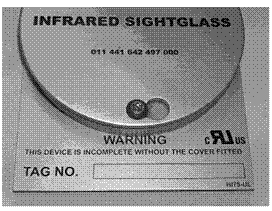
The C37.20.2 standard also incorporates a specific section relating to “Enclosure Openings” which must be taken into account if IR ports are being considered.
Paragraph A.3.3.1 “Enclosure Openings”, describes the minimum requirement for an opening in an enclosure. It should be noted that the “Enclosure Openings” and “Ventilation Openings” are referred to separately.
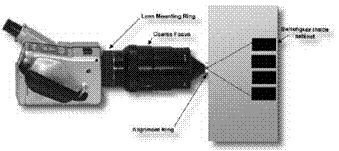
IR ports perform the same basic function as IR sightglasses except that the transmitting “medium” is a mesh, grill or open hole which allows infrared radiation to pass through. Obviously, such devices provide virtually no protection to the thermographer or operator in the event of an arc-flash event. In some equipment configurations where ventilation grills are required, they may be considered for use.
Figs. 2, 3 and 4 show a variety of infrared port designs, ranging from a mesh/grill option, which may be used with any infrared camera to a dedicated port and “fish-eye” type lens arrangement.
A screen barrier such as that shown in Fig. 5 provides excellent coverage to internal components but requires outer cover removal to complete the scan.
When utilizing such products, it must be clearly understood that the primary design and installation parameter is the diameter of the opening. The C37.20.2 standard, section A3.3.1, details the maximum enclosure opening, excluding ventilation openings, being no greater than 13mm (0.5”). The European Standard EN60529 incorporates a similar requirement, referred to as IP2X. IP2X defines protection against fingers or other objects not greater than 80mm in length and 12mm in diameter.
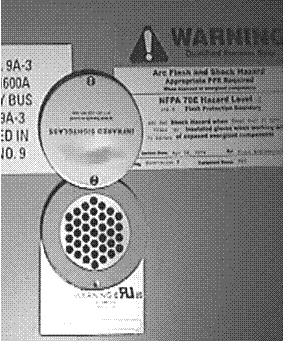 |
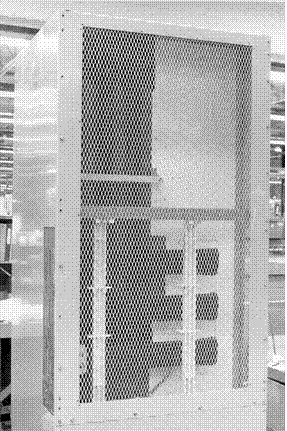 |
| Fig 4. Universal IR port and warning labeling |
Fig 5. Internal mesh screen for IR scanning |
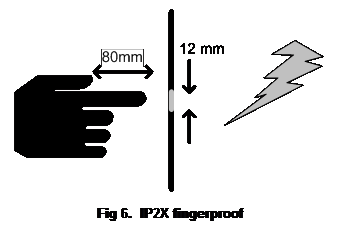
Fig. 6 shows the definition of the IP2X convention known as “fingerproof”. The rationale is to prevent a foreign object, the size of a human finger, from penetrating the equipment and coming into contact with live components.
The size of the opening and its environmental location (indoor or outdoor) must be seriously considered before installing an IR port. In order to install an IR port with an opening greater than 0.125” but less than the maximum 0.5” as required by C37.20.2 A3.3.1, certain clearances must be adhered to. Table 1 outlines these requirements.
|
Table 1
|
||
|
Rated Maximum
Voltage in kV |
Clearance
|
|
|
in.
|
cm.
|
|
| 4.76 |
5.5
|
14
|
| 8.25 |
6.5
|
17
|
| 15.0 |
8.0
|
20
|
| 27.0 |
12.0
|
30
|
| 38.0 |
15.0
|
38
|
For example: If the end use requirement is on a 15kV circuit breaker structure and the distance between the proposed IR port installation and the nearest un-insulated live part is less than 8” (20 cm) then the maximum opening or “hole” in the IR port or screen must be less than 0.125” (3.2mm).
The National Electric Code – NFPA 70 (NEC)
Unlike IEEE C37.20.20, which is specific to non arc-resistant metal-clad switchgear, the NEC is a generic standard relating to electrical equipment, both domestic and industrial. The most recent iteration of the NEC is the 2005 edition which was approved as an American National Standard on August 5, 2004.
The 2005 edition of the NEC includes for the first time a reference to “Flash Protection”. NEC paragraph 110.16 recognizing that switchgear, panelboards, industrial control panels, meter socket enclosures and motor control centers are to be field marked to warn users of a potential flash hazard. This is an important step forward in the codes, recognizing the increased awareness associated with arc-flash hazards and their impact on the maintenance and operation of electrical equipment.
The code includes a number of paragraphs that apply to the design and implementation of IR sightglasses and ports, with flash protection being the primary point.
As outlined earlier, although crystal optics used in some IR sightglasses can be designed to withstand the effects of pressure piling and temperatures associated with an arc-flash event, the optic cannot withstand day-to-day point impacts caused by careless personnel or the general public. To overcome this relatively minor problem, IR sightglasses are generally supplied with a locking protective cover as standard (Figs. 2 & 4). NEC section 110.31(D) confirms the requirement for such covers and guards to protect such openings.
Basic material recommendations for construction of electrical equipment are also covered in NEC 2005. Infrared sightglasses have a variety of possible areas of installation, including equipment such as transformers and motors and, as such, the construction material of the mounting ring and protective cover should also be considered.
Switchgear, motors, transformers, etc. are almost exclusively manufactured from metal and this same material has been the choice for IR sightglass manufacturers. IR sightglass installations into such areas as motor terminal boxes and switchgear structures require a similar level of protection as provided by the original material. NEC requires that motor terminal boxes be made from metal and be of substantial construction – the same should apply to an IR sightglass.
NEC section 490.40 also refers to “Inspection Windows” in that they simply require the optic to be of a suitable transparent material and require that cover plates be installed on openings to provide adequate protection when the opening is not in use.
IEC 62271-200 Arc-Resistant Switchgear
Perhaps the best overall standard applicable to IR windows for end-use application into arc-resistant switchgear is IEC62271-200, published in 2003. 62271-200 covers AC metal-enclosed switchgear and control gear for rated voltages above 1kV and up to and including 52kV and refers to standards such as IEEE C37.20.7:2001 as a guide for testing MV metal-enclosed switchgear for internal arcing faults.
Plastic materials used in the construction of a sightglass are obviously not acceptable for use on equipment whose end-use function is to prevent injury in the event of an electric arc. With respect to IR sightglasses, 62271-200 requires that covers and doors that are part of the enclosure shall also be metallic. Fig. 2 gives an example of an IR sightglass with a metallic cover.
IEC 62271-200, paragraph 5.102.4 – “Inspection Windows”, defines the requirements for inspection windows designed for installation into 1kV to 52kV arc-resistant equipment.
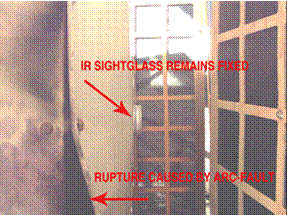
In accordance with this section, infrared sightglasses should:
a) Provide at least the degree of protection specified for the enclosure
b) Be covered by a transparent sheet with a mechanical strength comparable to that of the enclosure
Point a) refers to the environmental protection of the enclosure defined by EN60529 in Europe or by NEMA/UL50 in North America and requires that the sightglass installation does not de-rate the enclosure.
Point b) refers to the strength of the optic itself. If the optic material can pass all testing in accordance with paragraph A.6 “Acceptable Criteria”, then it can be deemed acceptable as a part of an IAC piece of equipment.
Fig. 7 illustrates the typical result of a 20kA arc-flash test in accordance with IEC62271-200 on a 12kV VCB with an IR sightglass installed.
The damage shown in Fig. 7 is the result of the dynamic pressure wave rather than the build-up of static pressure within the enclosure. In fact, as a result of this damage and corresponding pressure “relief”, the actual static pressure increase within the enclosure was minimal and extremely short lived.
This poses an interesting question when testing an IR sightglass for suitability of installation into equipment. Where there is the possibility of an arc-flash event, is static pressure testing enough or should a “dynamic” or thermoacoustic pressure test be required?
Although in this instance the IR sightglass optic shattered, it was deemed a result of the host equipment buckling rather than destruction due to the thermoacoustic pressure wave. As the cover and entire assembly remained attached to the panel and no material or arc gases were ejected, the IR sightglass passed the test in accordance with the acceptable criteria shown in Annex A of IEC 62271-200.
Melt Fabrics and Polymer Optics
Recently, lower cost IR windows have been introduced into the industry. Rather than using the traditional crystal-type optic, these products use a disc of a thin polymer material as the transmitting medium.
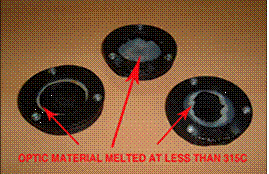
It is important to note that so called “melt-fabrics” are specifically prohibited by the standard for use with any FR PPE. This requirement obviously covers faceshields and as such, should also apply to infrared sightglass optics/lenses which are directly between the operator and the arc-flash.
“(a) Melting. Clothing made from flammable synthetic materials that melt at temperatures below 315°C (600F), such as acetate, nylon, polyester, polypropylene, and spandex, either alone or in blends, shall not be used.” NFPA70E 130.7(14)(a).
Such fabrics may cause severe contact/melt burns under a fault condition, even though basic impact resistance of such materials is good. The sudden increase in temperature and pressure associated with an arc flash, causes the optic to change into what is ultimately a molten projectile.
Fig. 8 shows the effect of a UL 746C type burn test on a polymer optic IR window. It is clear that in order for the “optic” to be infrared transmissive, its thickness must be such that it has no thermal endurance. In fact, testing shows that such materials melt at temperatures less than 100°C, far less than the 315°C required by NFPA 70E for synthetic PPE. Even if such materials are backed onto supporting mesh, the polymer optic will fail in the same manner causing a dangerous scenario, potentially involving a molten polymer projectile.
Since OSHA 29 CFR 1910.269 prohibits garments which contribute to burn severity, it is the author’s opinion that such thin film polymer optics, even mesh reinforced options that can literally comply with basic impact tests such as IEEE C37.20.2 A3.6, cannot be used in equipment with the capability to sustain an electric arc. Such products must be limited to <50V control equipment that, due to electrical or mechanical interlock devices, prevents door or cover removal and has no requirement for a high strength arc resistant crystal optic.
It is important to be clear as to the reason for installing IR sightglasses and for the philosophy behind the present switchgear and electrical equipment standards. As discussed earlier in this paper, the primary driving force behind the installation of infrared sightglasses is NFPA 70E as a method for reducing arc-flash danger and injury.
In fact, in response to an inquiry on OSHA’s stand on arc-flash hazard, Richard S. Terrili, the Regional Administrator for Occupational Safety and Health, US Department of Labor for the Northwest Region at Seattle, concluded as follows:
“Though OSHA does not, per se, enforce the NFPA standard, 2000 Edition, OSHA considers the NFPA standard a recognized industry practice. The employer is required to conduct assessment in accordance with CFR 1910.132(d)(1). If an arc-flash hazard is present, or likely to be present, then the employer must select and require employees to use the protective apparel. Employers who conduct the hazard/risk assessment, and select and require their employees to use protective clothing and other PPE appropriate for the task, as stated in the NFPA 70E standard, 2000 Edition, are deemed in compliance with the Hazard Assessment and Equipment Selection OSHA standard.”
NFPA 70E requires that employees wear appropriate flame resistant (FR) protective clothing if performing “live” work within the arc-flash boundary. The closest equivalent to an IR sightglass contained within NFPA 70E is the faceshield. Both being transparent; one being optical and one being an infrared.
Article 130 Table 130.7(C)(8) dictates how to properly test and assess face protective products such that they hold an “Arc Rating” which can be incorporated into an FR PPE configuration in accordance with article 130.7(C)(13)(b). This rating is quantified in cal/cm2. Table 2 illustrates how to relate this rating into a hazard/risk category such that appropriate options can be selected.
|
Table
|
||
|
PPE Selection Table
|
||
| Hazard/Risk Category |
CLOTHING DESCRIPTION
(Typical number of clothing layers is given in parentheses) |
Required minimum Arc-Rating of PPE (cal/cm2)
|
| 0 |
Non-melting, flammable materials 4.5 oz. (1)
|
N/A
|
| 1 |
FR shirt and FR pants (1)
|
4
|
| 2 |
Cotton underwear, plus FR shirt and FR pants (2)
|
8
|
| 3 |
Cotton underwear, plus FR shirt and FR pants, plus FR coverall (3)
|
25
|
| 4 | Cotton underwear, plus FR shirt and FR pants, plus double-layer switching coat and pants (4) | 40 |
Using this methodology, it is now possible to provide a meaningful arc rating of an IR sightglass that is applicable to different equipment at different voltages but can be considered “generic”.
Assessing the Risks Associate with IR Sightglasses
Ultimately, the installation of IR sightglasses, as with the use of any PPE, is a method to reduce the risk associated with a specific task.
The definition of “risk” is “the possibility of loss or injury”. The installation of an IR sightglass certainly helps in reduction, however, we must utilize the different optic options available in the most suitable end-use requirements in order to properly quantify “risk”.
Since arc-flash radiant energy is not solely voltage dependant, it is not correct to place a voltage related restriction on the selection of IR sightglass optics. The exception is under circumstances where the voltage level is insufficient to strike and/or maintain an arc.
Appendix 1 shows a selection matrix detailing how to correctly select a minimum IR sightglass optic material based upon arc-flash protection end-use requirements and host equipment specifications.
Testing Methods for Infrared Sightglass Optics and Mountings
As a minimum, IR sightglasses should be tested for their ability to withstand typical end-use forces which have been demonstrated as arc-flash effect.
In relation to IR sightglasses, there are three primary effects of an electric arc-flash that must be considered and tested in order for the sightglass to be suitable for use and be a true risk reduction and injury mitigation tool. They are:
• Static internal pressure increase
• Dynamic “thermoacoustic” wave effects
• Heat-flux effects
Each point will be discussed in turn, with a conclusion as to acceptable test criteria.
Static Pressure Effects
The static pressure within a cubicle is basically a function of the internal volume. This can be expressed by the Ideal Gas Law.
For the purpose of calculations, it is convenient to place the Ideal Gas Law in the form:

where the subscripts i and f refer to the initial and final states of some process. If the temperature is constrained to be constant, this becomes:

which is referred to as Boyle’s Law.
If the pressure is constant, then the Ideal Gas Law takes the form:

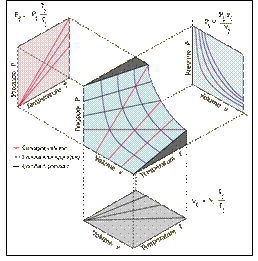
which has been historically called Charles’ Law. It is appropriate for experiments performed in the presence of a constant atmospheric pressure.
All the possible states of an ideal gas can be represented by a pVT surface as illustrated in Fig. 9. The behavior when any one of the three state variables is held constant is also shown.
As described in the earlier example, static pressure testing only represents one of the effects of an arc fault. By combining all three test variables represented in this section, we can get an accurate representation of the optic strength under a pVT effect which includes a thermoacoustic wavefront.
The simple relationship between pressure and volume can be derived as:
![]()
Graphically, this can be represented by Fig. 10, below:
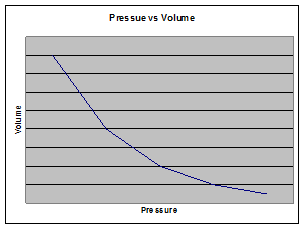
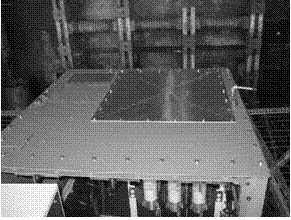
It is important to note that Volume is not equivalent to Area and as such, the general equation P = F/A does not apply.
During an electrical arc-flash event, the static pressure within an enclosure increases until either:
a) A pre-designed pressure relief system, such as a vent, operates (Figs. 13 & 14)
b) Physical disintegration of the system causes pressure relief (Fig. 7)
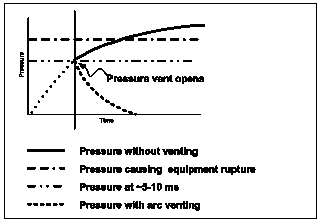
Fig. 11 shows an example of a pressure relief system. Various iterations of this design type are now incorporated into what is known as arc-resistant control equipment.
The pressure relief system operates as a result of the thermoacoustic wave discussed in the next section. It does not operate due to the static pressure build-up. As a result, the internal static pressure reduces.
Fig. 12 denotes the pressure build-up and release as a function of time inside an arc-resistant piece of switchgear. The maximum pressure measured was approximately 19 psi.
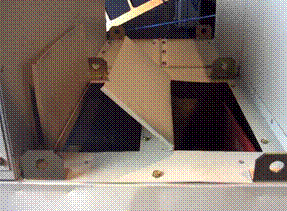
Fig. 12 clearly shows the increase in pressure associated with an arc-flash and the resultant drop in pressure due to the operation of the relief system.
In order to correctly test an IR sightglass optic for its ability to withstand the static pressures associated with an arc-flash event, a modified hydrostatic test must be performed. Industry standards relating to this type of testing require that the maximum operating pressure be increased by 150% for the duration of the test.
As the maximum pressure seen in an arc-flash event is 19 psi, a 150% increase equates to a minimum static pressure requirement for an IR sightglass optic of 28 psi.
Thermoacoustic Effects
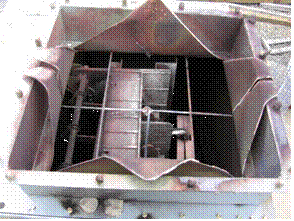
Arguably, the most destructive force seen during an arc-flash event is the dynamic pressure increase, known as the thermoacoustic wave. The thermoacoustic wave is a function of the short-circuit current and is present regardless of the equipment volume.
This shock wave can create impulse sound levels well beyond OSHA’s allowable limits. Forces from the pressure wave can rupture eardrums, collapse lungs or cause fatal injuries.
The thermoacoustic wave is used to operate pressure relief systems built into arc-resistant switchgear, which ultimately reduces the internal pressure in the equipment as discussed in the previous section.
Clearly, a static pressure of 19 psi will not result in such a ferocious operation. The buckling shown in Fig. 15 is the direct result of the shock wave caused under a 20kA for 0.1 sec arc-flash.
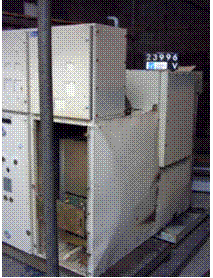
“Arc-resistant” switchgear is designed to withstand a combination of: static pressure, temperature and dynamic pressure under an arc-fault event.
Heat-Flux Effects
Existing arc-flash tests can be used to calculate a heat-flux level at the IR sightglass and are indeed a “worst-case” scenario, as the testing invariably includes pressure piling effects associated with arc-resistant host switchgear.
|
Example of IR sightglass heat-flux calculation based on existing test data:
BackgroundIR sightglass is tested on a host piece of arc-resistant equipment in accordance with C37.20.7-2001. Nominal Minimum Voltage – 7.2kV Maintained Fault Current – 40kA Approximate Phase-to-Phase Arc-Gap – 5” Distance of IR Sightglass Optic from Arc – 17.75” Arc Data (Calculated)*Arc Column Area – 143.4421 sq. inches Arc Diameter – 9.13187 inches Arc Power in Watts – 5,937,500 Watts Arc Power in Calories per Second – 1,418,469 Heat Flux on Surface of Arc – 1533.146 cal/cm2 – sec Heat Flux on Sightglass – 86.52 cal/cm2 – sec Total Calories per Sq. Cm. at Sightglass – 43.2 86.52 cal/cm2 – secTHIS EQUATES TO A LEVEL 4 HAZARD / RISK CATEGORY *data acquired using Duke Power Heat-Flux calculator |
As can be seen from the example above, it is possible to test and calculate the resilience of an IR sightglass optic for resistance to electric arc-flash in a similar manner as the in-place arc rating in cal/cm2 standard for faceshields.
Conclusion
IR sightglasses and ports are an invaluable method for reducing the risk associated with infrared inspection of energized equipment in accordance with OSHA and NFPA 70E. However, manufacturing an infrared sightglass & port is not as simple as installing an IR transmissive material, regardless of its properties, into a mounting ring and subsequently into a piece of equipment.
Due to the relatively recent introduction of IR sightglass & port technology, current standards do not properly address the requirements for correct testing and validation of design and material selection. With arc-flash safety and NFPA 70E being the primary driving factors behind the installation of infrared sightglasses, any standard must address the combined potential effects of:
• Heat flux at the sightglass location
• Maximum static pressure
• Thermoacoustic pressure
The selection of optic materials must be regulated by the underlying philosophies associated with end-use requirements, government legislation and in-place arc-flash safety documents such as NFPA 70E.
Synthetic / Polymer materials should be deemed acceptable for IR sightglass optics if the above three tests can be successfully completed and the optic material itself does not melt at less than 315°C in accordance with NFPA 70E guidelines for arc-flash PPE utilizing synthetic materials. Synthetic / Polymer materials which cannot withstand the above tests should be limited to systems with a maximum operating voltage of 50V.
Appendix 1
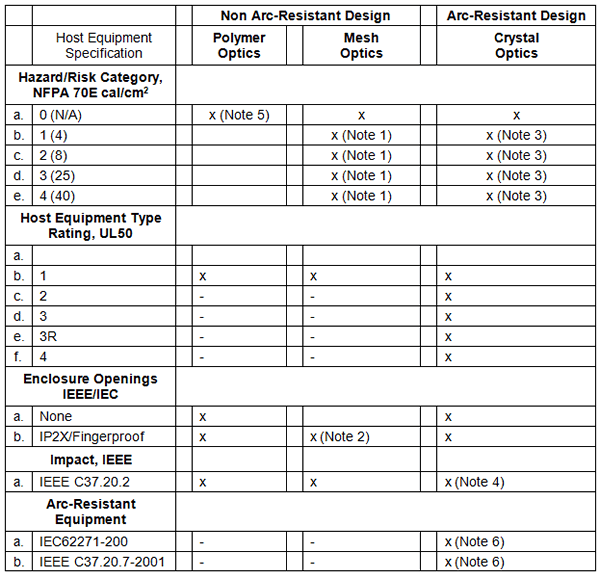
Notes:
1. Only install mesh, grid or port options if the host equipment incorporates open louvers
2. Opening diameter during operation should comply with local regulations to prevent foreign object intrusion in accordance with EN60529 IP2X or IEEE C37.20.2
3. Crystal optic options installed into Hazard/Risk Categories greater than 0 should have third party arc-flash tests performed in order to assess maximum heat flux endurance of the optic. Untested crystal optics should not be used
4. Crystal optics versions shall incorporate a locking metallic cover able to withstand daily impacts in accordance with IEEE C37.20.2 A3.6
5. Thin film polymer optics may only be used on Hazard/Risk Category Level 0 or as part of systems with an operating voltage of 50V or less
6. Crystal optics installed into equipment tested to arc-resistant requirements must have been subjected to internal-arc tests of the applicable standard in order to be acceptable
Advertisement


